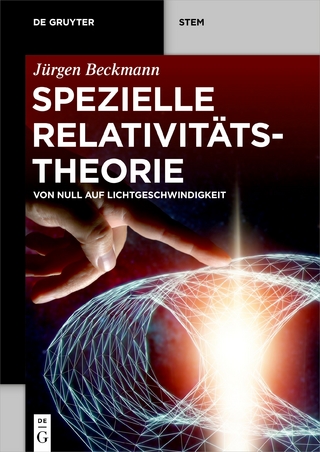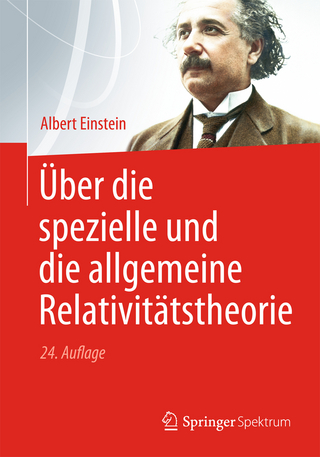
Practical Relativity
Wiley-Blackwell (Verlag)
978-0-470-74141-2 (ISBN)
- Titel ist leider vergriffen;
keine Neuauflage - Artikel merken
Chapter 6 will present astronomical applications of relativistic gravity. These include the usual solar system tests; light bending, time delay, gravitational red-shift, precession of Keplerian orbits. Chapter 7 will be dedicated to relativistic cosmology. Many of the standard cosmological concepts will be introduced, being mathematically simple but conceptually subtle. The concluding chapter will be largely dedicated to the global positioning system as an engineering problem that requires both inertial and gravitational relativity. The large interferometers designed as gravitational wave telescopes will be discussed here.
Professor Richard Henriksen is a full professor of astrophysics at Queen's University, Kingston (Canada). He was awarded his PhD at Manchester (UK) and he has been a senior visitor at Stanford (USA), a Humbolt Fellow in Germany and Engineur/chercheur at CEA Saclay in France. Professor Henriksen has published over 125 research papers of various kinds, many of which employ relativistic concepts. Together with Geoff Bicknell, he published in the astrophysical journal one of the first papers in which the formation of primordial black holes was calculated correctly. He has extensive experience lecturing, having lectured at all graduate and undergraduate levels in physics of most types. He has in addition presented many professional colloquia and has won the Queen’s University research excellence award. His areas of research range widely over the field of astronomy and astrophysics.
Preface ix
Acknowledgements xi
Introduction xiii
Part I: The World Without Gravity 1
1. Non-Relativity for Relativists 3
1.1 Vectors and Reference Frames 3
1.1.1 Reference Frames 4
1.1.2 Inertial Reference Frames 25
2. Invariance of Physical Law Under Change of Inertial Frame of Reference 45
2.1 Prologue 45
2.2 The Theory of Light or Electromagnetic Waves 48
2.2.1 Wave Propagation Speed 48
2.3 Measurement Theory and the Lorentz Transformations 62
3. Implications: Using and Understanding the Lorentz Transformations 79
3.1 Prologue 79
3.2 Kinematic Applications 80
3.2.1 Time 80
3.2.2 Time and Rotation 91
3.2.3 Time and the Lorentz Transformation 93
3.2.4 Space 94
3.2.5 Space and Time 99
3.3 Kinematic Acceleration 101
3.3.1 Thomas Precession 104
3.4 Geometrical Optics 108
3.4.1 Pictures of Moving Objects 111
3.4.2 Light Echoes 118
4. The Measure of Space-Time 123
4.1 Prologue 123
4.2 Metric Space-Time 124
4.2.1 Two Metric Derivations of the Lorentz Transformation 133
4.3 Four-Vector Dynamics 136
4.3.1 Lagrangian Dynamics Without Fundamental Forces 140
4.3.2 Collisions Between Free Particles 152
5. Electromagnetic Theory in Space-Time 161
5.1 Prologue 161
5.1.1 Electromagnetic Four-Potential 162
5.2 Lagrangian Dynamics of an Electromagnetic Charge 165
5.2.1 Field Transformations Between Inertial Frames 179
5.3 Electromagnetism for Arbitrary Inertial Observers 182
5.3.1 Curvilinear Electromagnetic Theory 192
Part II: Relativity With the Gravitational Field 203
6. Gravitational Structure of Space-Time 205
6.1 Prologue 205
6.2 The Weak Gravitational Field 209
6.3 Constant or Stationary Gravitational Field 215
6.4 Strong Gravitational Field 222
6.4.1 The Schwarzschild Metric 222
6.4.2 Orbital Precession and Light Bending in a Schwarzschild Geometry 229
6.4.3 Kerr Metric Outside a Rotating Mass 240
6.4.4 Relativistic Continua 244
6.4.5 The Curvature of Space-Time 247
Index 257
| Erscheint lt. Verlag | 1.11.2010 |
|---|---|
| Verlagsort | Hoboken |
| Sprache | englisch |
| Maße | 162 x 233 mm |
| Gewicht | 426 g |
| Themenwelt | Naturwissenschaften ► Physik / Astronomie ► Relativitätstheorie |
| ISBN-10 | 0-470-74141-4 / 0470741414 |
| ISBN-13 | 978-0-470-74141-2 / 9780470741412 |
| Zustand | Neuware |
| Haben Sie eine Frage zum Produkt? |
aus dem Bereich


